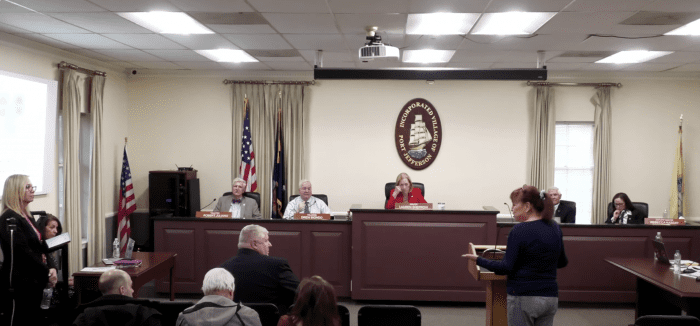Green energy update
Last Friday, May 10, Xena Ugrinsky, Port Jefferson energy committee chairperson and I visited with Peter St. Germain, general manager, Terminalling, at Northville Industries on Belle Mead Road, East Setauket. Northville has proposed building warehouses or apartments on this site and Xena and I wanted to speak with St. Germain regarding its potential for future hydrogen storage. Northville Industries has a strategic importance for energy and the Long Island economy.
We discussed the economic demand for hydrogen, its fast-growing use in the new economy, the need to switch to green energy in the power generation and rail industries, and discussed, also, the speed of worldwide adoption of this fuel to reduce climate change.
St. Germain supports these green goals and reports that Gene Bernstein, Northville’s chairman, is already planning for a “4 Gen” green future. We can hope this site remains an energy site and is not intensely developed.
On Tuesday, April 30, I went into Manhattan to address the MTA board of directors. My request was simple — to have a meeting on green energy with Long Island Rail Road president Robert Free, a Port Jefferson Station resident. My time to speak was short. Janno Lieber, MTA’s chairman, was polite and did not yawn. The MTA is coming to an end of its 20-year planning for LIRR. I see no evidence of any desire of LIRR to accommodate state law or reduce carbon emissions.
I will be addressing the Three Village Civic Association and its president, Charles Tramontana, on this topic on Monday, June 3. I am discussing this issue with Port Jefferson Station/Terryville Civic Association president, Ira Costell; Port Jefferson Civic Association president, Ana Hozyainova; and county Legislator Steve Englebright [D-Setauket], sponsor of the New York Climate Leadership and Community Protection Act when he was an assemblyman. We would hope to petition Gov. Kathy Hochul [D] to support her own law for climate and green energy use.
We have proposals for Mr. Free for new technologies that make this transition far more feasible and economical — even beneficial to the New York state economy.
Green transportation: “A better ride” — a “one-seat ride” to Manhattan is critical to our North Shore environment and economy.
Contact your elected representatives. The MTA is getting $10 billion from the federal government to transition to green energy. I see no benefit to the North Shore from these funds. “We pay taxes, too.”
RSVP Mr. Free.
Bruce Miller
Port Jefferson
Celebrate your favorite waitstaff
Tuesday, May 21, is National Waitstaff Day. Your neighborhood restaurant waiters are on their feet all day working long hours. They take and deliver meal orders, follow up to make sure your meal is up to expectations, refill your coffee, tea or water glass, box any leftovers you want to take home and prepare the check — all with a smile and friendly disposition.
On this day, why not show your appreciation and honor your favorite waiter? Leave a 25 percent tip against the total bill including taxes. Remember that they usually have to share the tips with the busboys. Drop off some flowers, a box of candy or some cookies as well.
Larry Penner
Great Neck
Ceasefires do not work
In recent weeks, colleges and universities across the country have been visited by large groups of antisemitic activists, known as Palestine protesters, whose stated goal is the abolition of the state of Israel. Although it might be only partially accurate to describe these visitors as guest lecturers, they do share many of the same qualifications, as they teach students various things they need to know, including how to recite catchy slogans, the proper wearing of masks to avoid being identified and how to live in a tent.
Here in Stony Brook, the SUNY protesters seem to be doing well, and have branched out to beyond the confines of the university, with a few of them joining the ranks of the North Country Peace Group, which congregates on North Country Road in Setauket every Saturday morning from around 11 a.m. to 12:30 p.m., and has been doing so for many years.
On the opposite side of the street, the Stony Brook Patriots meet at the same time, for the purpose of countering most of the positions advocated by NCPG. For motorists passing by, the two sides are easily distinguished: NCPG displays three flags: a Black Lives Matter flag, a U.N. flag and, most recently, a Palestine flag. The Patriots, on the other hand, display only two types of flags: about a dozen examples of the American stars and stripes, and a single flag of the nation of Israel.
The members of the Patriots believe that advocating for peace, while at the same time supporting Palestine — which implies support for Hamas — is inconsistent and hypocritical.
Last Oct. 7, Hamas perpetrated a murderous, unprovoked attack on the civilian citizens of Israel, an atrocity unmatched since the Holocaust and World War II. After the Empire of Japan attacked Pearl Harbor and the United States, we had no viable option other than to wage war against Japan and achieve an unconditional surrender. If Japan had requested a ceasefire a few months after Pearl Harbor, it would not have been considered. As it turned out, the United States and the Allies decisively defeated both Japan and Germany, and prosecuted and punished the criminal leaders of both countries.
“Peace Through Strength” is a concept that has been espoused by many of our great leaders, from George Washington through Ronald Reagan, and the leaders of Israel know that it applies today. As British Prime Minister Neville Chamberlain showed us in 1938, appeasement and ceasefires do not work.
George Altemose
Setauket














